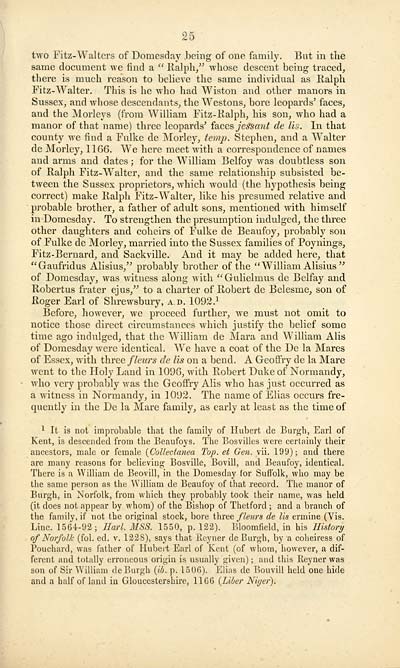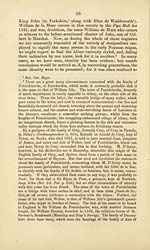Notices of the Ellises of England, Scotland, and Ireland, from the conquest to the present time
(41) Page 25
Download files
Complete book:
Individual page:
Thumbnail gallery: Grid view | List view

25
two Fitz-Waltcrs of Domesday .being of one family. But in the
same document we find a " Ralph," whose descent being traced,
there is much reason to believe the same individual as Ralph
Fitz- Walter. This is he who had Wiston and other manors in
Sussex, and whose descendants, the Westons, bore leopards' faces,
and the Morleys (from William Fitz- Ralph, his son, who had a
manor of that name) three leopards' faces jessant de lis. In that
county we find a Fulke de Morley, temp. Stephen, and a Walter
de Morley, 1166. We here meet with a correspondence of names
and arms and dates ; for the William Belfoy was doubtless son
of Ralph Fitz-Walter, and the same relationship subsisted be-
tween the Sussex proprietors, which would (the hypothesis being
correct) make Ralph Fitz-Walter, like his presumed relative and
probable brother, a father of adult sons, mentioned with himself
in Domesday. To strengthen the presumption indulged, the three
other daughters and coheirs of Fulke de Beaufoy, probably son
of Fulke de Morley, married into the Sussex families of Poynings,
Fitz-Bernard, and Sackville. And it may be added here, that
"Gaufridus Alisius," probably brother of the "William AUsius"
of Domesday, was witness along with "Gulielinus de Belfay and
Robertus frater ej us," to a charter of Robert de Belesme, son of
Roger Earl of Shrewsbury, ad. 1092. :
Before, however, we proceed further, we must not omit to
notice those direct circumstances which justify the belief some
time ago indulged, that the William de Mara and William Alis
of Domesday were identical. We have a coat of the De la Mares
of Essex, with three fleurs de lis on a bend. A Geoff ry de la Mare
went to the Holy Land in 1096, with Robert Duke of Normandy,
who very probably was the Geoffry Alis who has just occurred as
a witness in Normandy, in 1092. The name of Elias occurs fre-
quently in the De la Mare family, as early at least as the time of
1 It is not improbable that the family of Hubert de Burgh, Earl of
Kent, is descended from the Beaufoys. The Bosvilles were certainly their
ancestors, male or female {Collectanea Top. et Gen. vii. 199); and there
are many reasons for believing Bosville, Bovill, and Beaufoy, identical.
There is a William de Beovill, in the Domesday for Suffolk, who may be
the same person as the William de Beaufoy of that record. The manor of
Burgh, in Norfolk, from which they probably took their name, was held
(it does not appear by whom) of the Bishop of Thetford ; and a branch of
the family, if not the original stock, bore three fleurs de lis ermine (Vis.
Line. 1564-92; Harl. MSS. 1550, p. 122). Bloomfield, in his History
of Norfolk (fob ed. v. 1228), says that Eeyner de Burgh, by a coheiress of
Pouchard, was father of Hubert Earl of Kent (of whom, however, a dif-
ferent and totally erroneous origin is usually given) ; and this Keyner was
son of Sir William de Burgh {id. p. 1506). Elias de Bouvill held one hide
and a half of land in Gloucestershire, 1166 {Liber Niger).
two Fitz-Waltcrs of Domesday .being of one family. But in the
same document we find a " Ralph," whose descent being traced,
there is much reason to believe the same individual as Ralph
Fitz- Walter. This is he who had Wiston and other manors in
Sussex, and whose descendants, the Westons, bore leopards' faces,
and the Morleys (from William Fitz- Ralph, his son, who had a
manor of that name) three leopards' faces jessant de lis. In that
county we find a Fulke de Morley, temp. Stephen, and a Walter
de Morley, 1166. We here meet with a correspondence of names
and arms and dates ; for the William Belfoy was doubtless son
of Ralph Fitz-Walter, and the same relationship subsisted be-
tween the Sussex proprietors, which would (the hypothesis being
correct) make Ralph Fitz-Walter, like his presumed relative and
probable brother, a father of adult sons, mentioned with himself
in Domesday. To strengthen the presumption indulged, the three
other daughters and coheirs of Fulke de Beaufoy, probably son
of Fulke de Morley, married into the Sussex families of Poynings,
Fitz-Bernard, and Sackville. And it may be added here, that
"Gaufridus Alisius," probably brother of the "William AUsius"
of Domesday, was witness along with "Gulielinus de Belfay and
Robertus frater ej us," to a charter of Robert de Belesme, son of
Roger Earl of Shrewsbury, ad. 1092. :
Before, however, we proceed further, we must not omit to
notice those direct circumstances which justify the belief some
time ago indulged, that the William de Mara and William Alis
of Domesday were identical. We have a coat of the De la Mares
of Essex, with three fleurs de lis on a bend. A Geoff ry de la Mare
went to the Holy Land in 1096, with Robert Duke of Normandy,
who very probably was the Geoffry Alis who has just occurred as
a witness in Normandy, in 1092. The name of Elias occurs fre-
quently in the De la Mare family, as early at least as the time of
1 It is not improbable that the family of Hubert de Burgh, Earl of
Kent, is descended from the Beaufoys. The Bosvilles were certainly their
ancestors, male or female {Collectanea Top. et Gen. vii. 199); and there
are many reasons for believing Bosville, Bovill, and Beaufoy, identical.
There is a William de Beovill, in the Domesday for Suffolk, who may be
the same person as the William de Beaufoy of that record. The manor of
Burgh, in Norfolk, from which they probably took their name, was held
(it does not appear by whom) of the Bishop of Thetford ; and a branch of
the family, if not the original stock, bore three fleurs de lis ermine (Vis.
Line. 1564-92; Harl. MSS. 1550, p. 122). Bloomfield, in his History
of Norfolk (fob ed. v. 1228), says that Eeyner de Burgh, by a coheiress of
Pouchard, was father of Hubert Earl of Kent (of whom, however, a dif-
ferent and totally erroneous origin is usually given) ; and this Keyner was
son of Sir William de Burgh {id. p. 1506). Elias de Bouvill held one hide
and a half of land in Gloucestershire, 1166 {Liber Niger).
Set display mode to:
![]() Universal Viewer |
Universal Viewer | ![]() Mirador |
Large image | Transcription
Mirador |
Large image | Transcription
Images and transcriptions on this page, including medium image downloads, may be used under the Creative Commons Attribution 4.0 International Licence unless otherwise stated. ![]()
| Histories of Scottish families > Notices of the Ellises of England, Scotland, and Ireland, from the conquest to the present time > (41) Page 25 |
|---|
| Permanent URL | https://digital.nls.uk/95546105 |
|---|
| Description | A selection of almost 400 printed items relating to the history of Scottish families, mostly dating from the 19th and early 20th centuries. Includes memoirs, genealogies and clan histories, with a few produced by emigrant families. The earliest family history goes back to AD 916. |
|---|

